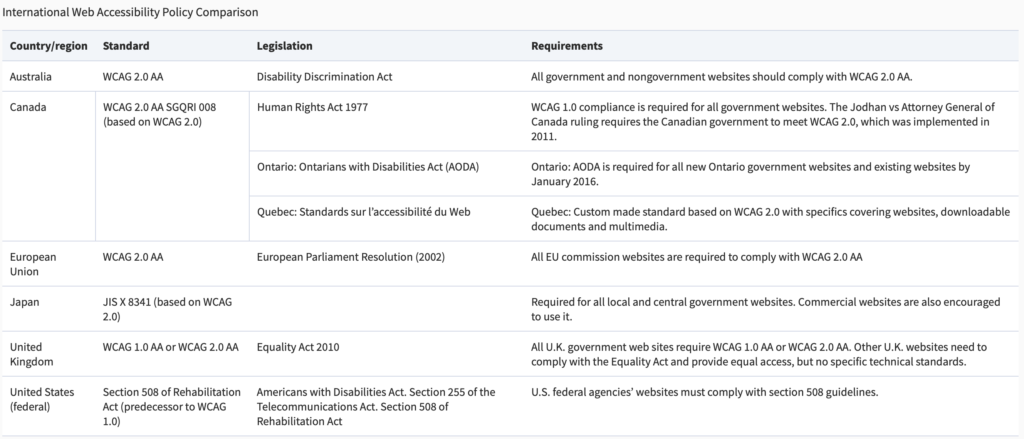There are different laws that are put in place to mandate web accessibility. Accessibility standards across softwares and certain web pages are set. Different governments, universities, industries, etc. have their own methods and ways of accessibility implementation. There’s not a common language that covers all.
Adoption or acceptance of technology? Adoption is more of a process of embracing and experiencing through time while acceptance is just the attitude. Full acceptance brings adoption and full acceptance can only be achieved by full usage ability, hence accessibility.
Benefits of using a technology must outweigh the effort of learning to use it for most elderly this is why usability is so important for user interfaces that seeks inclusion.
The Web Accessibility Directive
Directive (EU) 2016/2102, in force since 22 December 2016, will provide people with disabilities with better access to the websites and mobile apps of public services.[1]
The European Commission states that approximately 10–15% of the population of Europe suffers from some disability, and it acknowledges that “[t]here is a strong correlation between disability and ageing” ( EC, 2014 ).[2]



Some examples for digital accessibility:
- Screen readers that parse a website for a user with visual impairments
- Videos on websites are closed-captioned for individuals with hearing impairments
- Images include “alt text” for individuals with visual impairments
- Websites must be navigable by keyboard for users who may not be able to operate a mouse (i.e., navigating using the “Tab” on a keyboard)
71% of web users with a disability will simply leave a website that is not accessible, users without disabilities find accessibility features help them navigate your site more effectively. When you maintain an accessible digital presence, all your visitors benefit.
Siteimprove
Sources
- Kulkarni, Mukta. “Digital Accessibility: Challenges and Opportunities.” IIMB Management Review 31.1 (2019): 91-98. Web.
- Vigouroux, Nadine, Campo, Eric, Vella, Frédéric, Caroux, Loïc, Sacher, Mathilde, Istrate, Dan, Lompré, Nicole, Gorce, Philippe, Jacquier-Bret, Julien, Pinède, Nathalie, Serpa, Antonio, and Van Den Bossche, Adrien. “Multimodal Observation Method of Digital Accessibility for Elderly People.” Ingénierie Et Recherche Biomédicale (2020): Ingénierie Et Recherche Biomédicale, 2020-04. Web.
- Adriano, Adrian. “Digital Accessibility for All.” Design Cost Data 63.3 (2019): 51-52. Web.
- Ferreira, Simone, Sacramento, Carolina, Da Silva Alves, Aline, Leitão, Carla, Maciel, Denise, Matos, Simone, and Britto, Talita. “Accessibility and Digital Inclusion.” Proceedings of the XVI Brazilian Symposium on Human Factors in Computing Systems (2017): 1-6. Web.
- Abascal, Julio, Abascal, Julio, Barbosa, Simone D. J, Barbosa, Simone D. J, Nicolle, Colette, Nicolle, Colette, Zaphiris, Panayiotis, and Zaphiris, Panayiotis. “Rethinking Universal Accessibility: A Broader Approach considering the Digital Gap.” Universal Access in the Information Society 15.2 (2016): 179-82. Web.
- Duplaga, Mariusz. “Digital Divide among People with Disabilities: Analysis of Data from a Nationwide Study for Determinants of Internet Use and Activities Performed Online.” PloS One 12.6 (2017): E0179825. Web.
- Da Silva, Viviane, Silva De Souza, Ranniéry, Oliveira, Mafalda, and Medeiros, Rafael. “Web Accessibility for Elderly.” Proceedings of the 9th International Conference on Theory and Practice of Electronic Governance (2016): 367-68. Web.
- https://uxdesign.cc/accessible-ui-and-inclusive-design-38fe6e680282
- https://www.codecademy.com/articles/what-is-digital-accessibility
- https://siteimprove.com/en-ca/accessibility/what-is-accessibility/
- [1] https://ec.europa.eu/digital-single-market/en/web-accessibility
- [2] Y. Tony Yang, LLM, LLCM, ScD, MPH, Brian Chen, JD, PhD, Web Accessibility for Older Adults: A Comparative Analysis of Disability Laws, The Gerontologist, Volume 55, Issue 5, October 2015, Pages 854–864, https://doi.org/10.1093/geront/gnv057